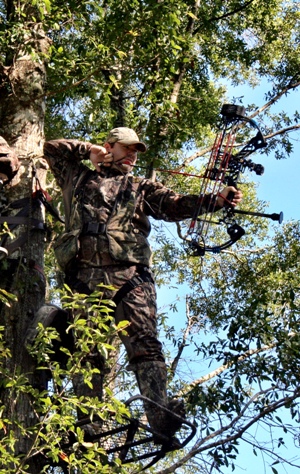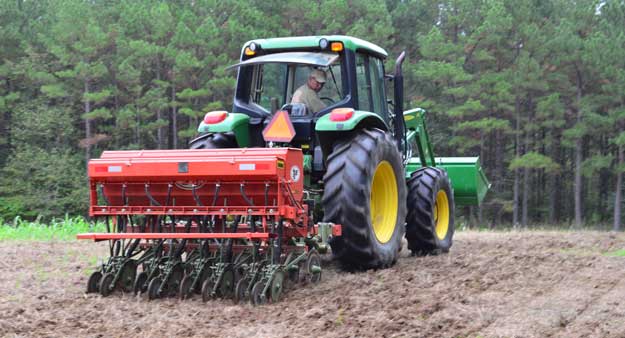 Editor’s Note: Mossy Oak Pro Lance Howard lives in Theodore, Alabama, just south of Mobile, in one of the southernmost sections of Alabama. During the Great Depression of the 1930s, when deer and turkey were nearly wiped out across Alabama, large landowners in south Alabama protected the deer and turkeys on their lands. Today these many south Alabama deer have resulted in overpopulation of the deer herd there. Howard has lived on his family’s 3,500 acre peanut and cotton farm all his life and has developed strategies for taking deer there.
Editor’s Note: Mossy Oak Pro Lance Howard lives in Theodore, Alabama, just south of Mobile, in one of the southernmost sections of Alabama. During the Great Depression of the 1930s, when deer and turkey were nearly wiped out across Alabama, large landowners in south Alabama protected the deer and turkeys on their lands. Today these many south Alabama deer have resulted in overpopulation of the deer herd there. Howard has lived on his family’s 3,500 acre peanut and cotton farm all his life and has developed strategies for taking deer there.
I'm often asked, “Why do you wear Mossy Oak? ”I wear Mossy Oak because I like the camouflage and the company’s philosophy. Not only do the people at Mossy Oak teach habitat management and conservation, they live those philosophies. They're more than just a brand of camouflage. They embrace the total outdoor lifestyle. When I'm asked what’s my favorite pattern for deer hunting, often, people are surprised by my answer. I like Mossy Oak Obsession for hunting deer and turkeys. Because I live in the Deep South, when bow season comes in about mid-October, everything is still very green, and our forest woodlands will be green until mid-December. So, all the green in Mossy Oak Obsession is really appropriate throughout most of deer season where I live and hunt.
One of the biggest problems we have with our deer herd herein South Alabama is we have too many deer and too much hunting pressure to allow our deer to grow big antlers and heavy body weights. On an average morning hunt, whether I'm bowhunting or gun hunting, I may see from 5 to 15 deer from my stand. On an afternoon hunt, I’ll usually spot 10 to 30 deer. So, during a one day hunt, I easily may see 45 deer. The least amount of deer I expect to see on a morning and afternoon hunt will be 15. Although most of the deer I see will be does, I’ll also see a good number of spikes and 4-point bucks. These deer usually will be from 1-1/2 to 2-1/2-year-old bucks. Your best chances of taking an older buck - 3-1/2-years old or older - will be in the first few days of bow season or at the peak of the rut around Martin Luther King Day.
During the hunting season, we try and take at least 75 does off our land, which is the number we harvested last year. We butcher all of our deer, we eat what we can, and we give away the rest. We've only been harvesting does for about 17 or 18 years. In our area of south Alabama, a lot of hunters still don’t believe in harvesting does. My grandfather and my older uncles still won’t take a doe. You have to remember that right after the Great Depression of the 1930s, deer hunting was closed in almost all of Alabama. Then restocking began. To increase the number of deer available for hunters statewide, Alabama’s Department of Conservation preached the gospel, “If you shoot does, you won’t have any bucks.” This was the right philosophy at that time to increase the herd statewide. For a long time, that policy was in place, and any hunter who shot a doe was a social outcast. In the South, old ways of wildlife management gave up reluctantly to new research and better management practices. In the Deep South, especially in south Alabama, quite a few hunters still refuse to harvest does. They want to see a lot of deer when they go hunting, even if they're only seeing little bucks. So, because we have an overpopulation of deer, and most hunters are satisfied with taking a 3-1/2-year-old 8-point that has 14 inches between his main beams, a buck rarely has enough time and enough food to reach his full development capabilities in both antlers and body weight.
Twenty years ago, we often would see 50 to 75 deer in a food plot at one time, and you could actually see a browse line from the deer in most of the woods where we hunted. But when we had a biologist from Alabama’s Department of Conservation come in and do a survey, he told us we needed to start harvesting more does from our land. At that time, a trophy buck was an 8-point with 14 inches between his main beams. Now, we’re starting to see bucks that will score up to 141 inches Boone & Crockett, which is a monster buck for this part of south Alabama. Since we've tried to harvest does each season, we've seen a 30-percent growth in antler development on our bucks, although we’re still having a problem with overpopulation of our deer herd. To help us get the number of does we need to take off our land, we bring in youngsters and let them shoot does - as many as they can. Sometimes our doe harvest seems more like work than hunting, but we know we have to do it.
The biggest buck I've taken with a bow on our property is 110 inches. The biggest buck I've taken with a rifle on our farm has scored 125 inches. As I’ve mentioned earlier, in Alabama, we can take three bucks per season. Even though taking a limit of bucks is easy for me, many years, I won’t take that many bucks.I try to hunt for the most mature buck we have on our property. I determine which bucks are the most mature from the trail camera surveys I do all year long. I've learned that antler size doesn’t have anything to do with the age of a buck, when you're hunting in overpopulated places like ours.
The biggest buck taken on our property was a 141-inch buck, and he was only 5-1/2 years old. That was a monster buck for south Alabama. Even though we have 3,500 acres to hunt, there is deer hunting on all sides of our property. Our 3,500 acres is not all contiguous, so we have hunting clubs, hunting leases and private land hunters on all sides of our properties. If we could get our neighbors to not shoot the 3-1/2-year-old bucks and let those bucks move into the 4-1/2-year-old category, we could take much bigger bucks than we’re harvesting.
However, to really understand why we don’t practice better deer management, you have to remember that 20 years ago this area mostly homed 1-1/2-year-old bucks with very few bucks surviving to be 2-1/2-year-old bucks. Change takes place slowly here. However, at least now, we’re taking better bucks than we once have. We do have some of our neighbors who are trying to do the same thing we are with our deer management - allowing our 3-1/2-year-old bucks to walk. But, other neighboring properties haven’t decided to adhere to this philosophy.
To learn more about hunting, check out John E. Phillips’ new eBook and print book, “Bowhunting Deer: Mossy Oak Pros Know Bucks and Bows.” You also can download a free Kindle app that enables you to read the book on your iPad, computer or Smartphone.
For information on making jerky from your deer to provide a protein-rich snack, you can download a free book from http://johninthewild.com/free-books.
Day 3: Harvest a Doe Every Day and Three Bucks Per Season
Tomorrow: Howard’s System to Eliminate Human Odor






























